TEAC UD-H01 Balanced Headphone Amplifier Mod
By Rob Robinette
The TEAC HD-H01 is an excellent balanced output DAC (Digital to Analog Converter) but it's built-in headphone amp has only unbalanced (single-ended) output and is weak and cannot drive high impedance headphones at high volume. For about $24 you can add a nice high-power Tripath TA2024 based Class-T amp and 4-Pin Female XLR chassis connector for high quality balanced headphone output that can drive any headphone. The Tripath TA2024 is the amp chip in the very nice $89 Topping TP-10 amp. The TA2024 datasheet is here. I sourced the generic Tripath TA2024 amp board for $18 and a Neutrik 4-Pin Female XLR chassis connector for $6 from eBay. You'll be completely shocked how great these little amps sound with efficient speakers or high-end headphones.
UD-H01 With Balanced Headphone Amp & 4-Pin XLR
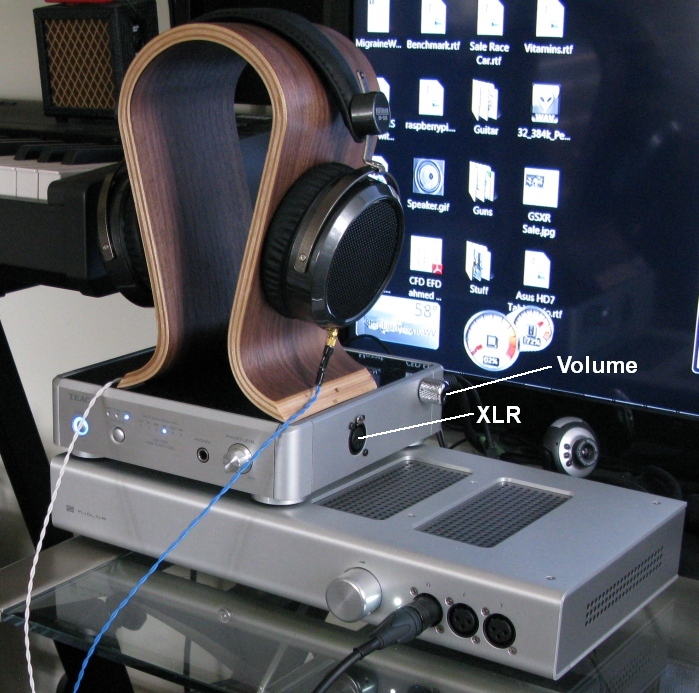
The HD-01 is sitting on top of a Schiit Mjolnir Balanced Headphone Amp
Unbalanced (single-ended) Vs. Balanced
A normal unbalanced (single-ended) headphone cable with a TRS (Tip-Ring-Sleeve) plug uses 2 signal wires to carry the Right and Left + signals and a grounded shield that carries the combined Right and Left negative signals (common ground). A balanced stereo cable needs four wires of equal gauge to carry L+ L- R+ and R-.
A 4 wire balanced line rejects RFI (radio frequency interference) and RMI (radio magnetic interference) naturally due to each stereo channel's two equal length and gauge wires both picking up the same interference--one wire is positive and the other is negative so when the signal from the two wires is combined the added noise cancels itself out. Adding a grounded shield to a balanced line will offer even more noise reduction. Using a balanced line also allows more efficient amplification schemes such as push-pull or differential amplification. For more information on balanced line theory and benefits see this wikipedia article.
Tripath TA2024 Class-T Amplifier
These Tripath TA2024 amp boards are so small they can fit into many DACs to transform them into DACs with high power balanced push-pull headphone output. The Tripath TA2024 chip itself has single-ended input (3.5mm TRS socket with R- and L- connected to ground) but has balanced push-pull output (L+ L- R+ R-).
Warning: The Tripath TA2024 and TA2020 are bridged push-pull amps and cannot be bridged at the output. They also cannot be used for direct unbalanced common ground output because they are push-pull amps so the two stereo negative (R- & L-) outputs cannot be combined or connected to ground. If you attempt to use push-pull Tripath amps with a common ground you will destroy the amp chip. These amp boards must be used with balanced line headphones or speakers.
The Tripath TA2024 Balanced Output Push Pull Amplifier
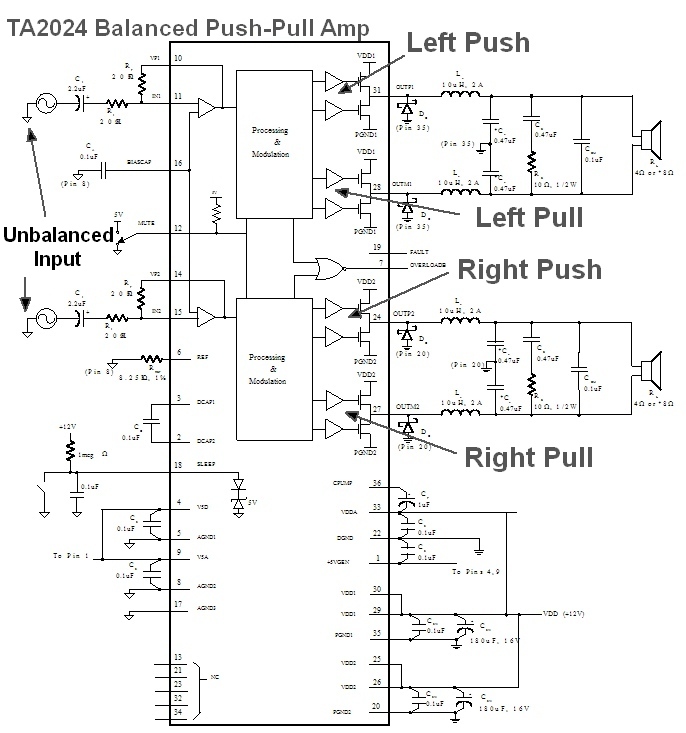
The Tripath TA2024 amplifier chip is a true balanced output push-pull amp. But it does use unbalanced input because the inputs use a common ground (left side of schematic).
The TA2022 Single-Ended Amp With Unbalanced Output
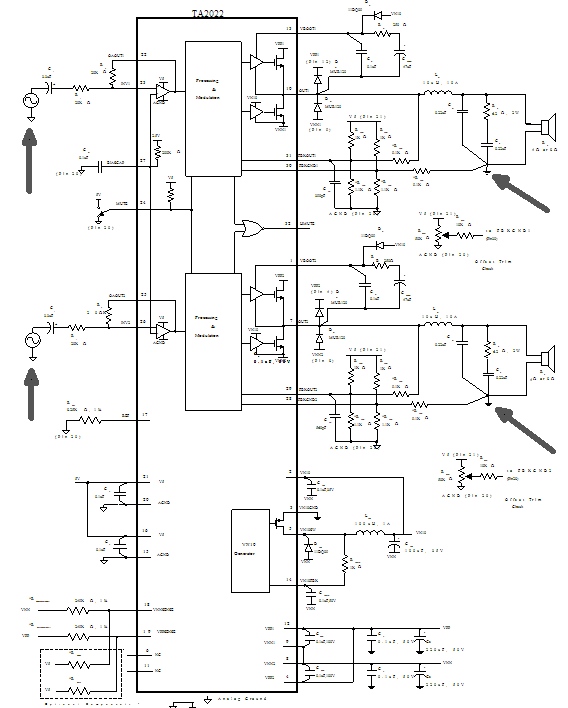
The Tripath TA2022 is a single-ended amplifier and uses unbalanced output. Note how one side of the speaker is connected to ground (common ground) so only the speaker's + terminal receives an amplified signal. The amp chip's input is also unbalanced (has common ground).
Class-T amps are super-efficient so they use a minimum of electrical power and generate low amounts of heat. The Tripath TA2024 is rated at 15 watts per channel into 4 Ohms with 0.1% total harmonic distortion so you don't have to worry about over powering your headphones with this amp board and the higher powered Tripath 2020 amp board is probably overkill. If you plan to drive speakers with an amp board then the TA2020 (20w into 4 Ohms) or TA2021 (25w into 4 Ohms) may be better but it requires more power and cooling. To get the full potential out of the higher powered Tripath TA2020 or TA2021 you'll probably need to power it with it's own 2 or 3 amp 12 volt power source. A separate TA2021 based amp like the $71 Topping TP21 probably makes more sense and can be found on eBay--just search for "Tripath 2021 amplifier."
Tripath Low Power Amp Chips
Push-Pull With Balanced Output
TA2020 20 watts into 4 Ohms in the Topping TP20 MKII
TA2021 25 watts into 4 Ohms In the Topping TP21
TA2024 15 watts into 4 Ohms in the Topping TP10
TK2050 50 watts in the Topping TP22
TK2051 50 watts
TK2070 70 watts
Single-Ended With Unbalanced Output
TA2022
TK2019
Modifying the UD-H01
The first step for this mod is to test the Tripath amp board with your DAC and headphones (or speakers) to make sure you like the sound before you begin to cut holes in your DAC case. I temporarily connected the amp board to the DAC using an RCA to 3.5mm TRS plug adapter cable. This will send the DAC's single ended signal from its RCA connectors to the amp board. The amp board needs a 12 volt power source which I had laying around. You can purchase one with the amp board or you can go ahead and tap into the DAC's 12 volt power lines (details in second picture below). I used a 4-Pin Female XLR to speaker-out adapter to temporarily connect my headphones to the amp board's speaker terminals.
Testing the Tripath TA2024 Amp Board
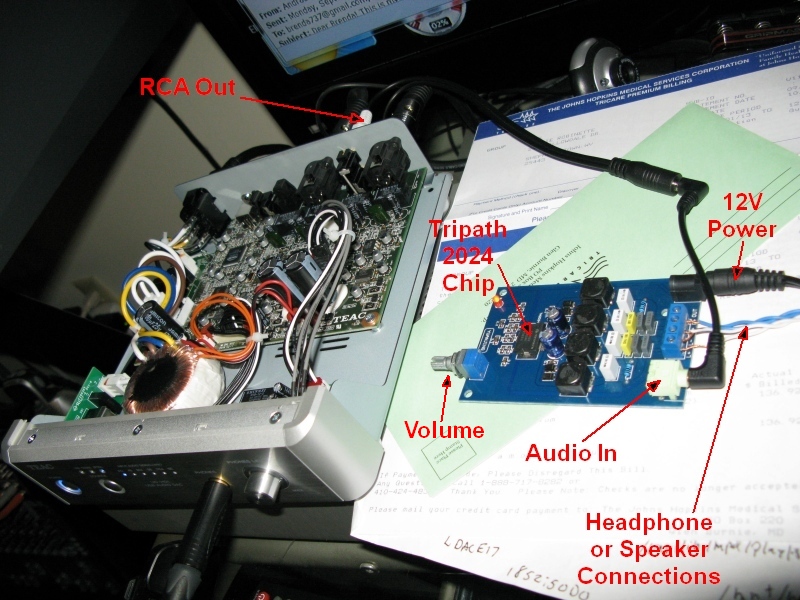
I tested the amp board's sound with this temporary hookup. It drove my HiFiMAN HE-500 headphones (32 ohms impedance) very well with lots of headroom to spare and should handle hard-to-drive 600 ohm headphones too.
If you're happy with the test then it's time to cut holes in the DAC's case. You'll need one hole for the amp board's volume control and one for the 4-Pin Female XLR chassis connector. I mounted the board and chassis connector to the case's top right side. There's room above the UD-H01's main circuit board for the Tripath amp board. Run 5 wires from the amp board's speaker outputs to the XLR chassis connector using this standard stereo audio 4-Pin XLR pinout:
Neutrik Female 4-Pin XLR Chassis Connector
XLR Pin Speaker Out
1 L+
2 L-
3 R+
4 R-
Ground Lug Metal chassis or amp board ground point
The XLR pin numbers are usually molded into the connector's plastic plug. If you use a 4 conductor shielded cable you can connect the cable's shield to the XLR ground lug and amp board ground point. This ground wire is important because the XLR chassis connector will be mounted to the plastic case so it will not be grounded unless you connect its ground lug to the amp board's ground or the metal chassis. The XLR ground will provide RFI shielding for the headphone cable (if the headphone cable has a shield).
UD-H01 Connections for Amp Board
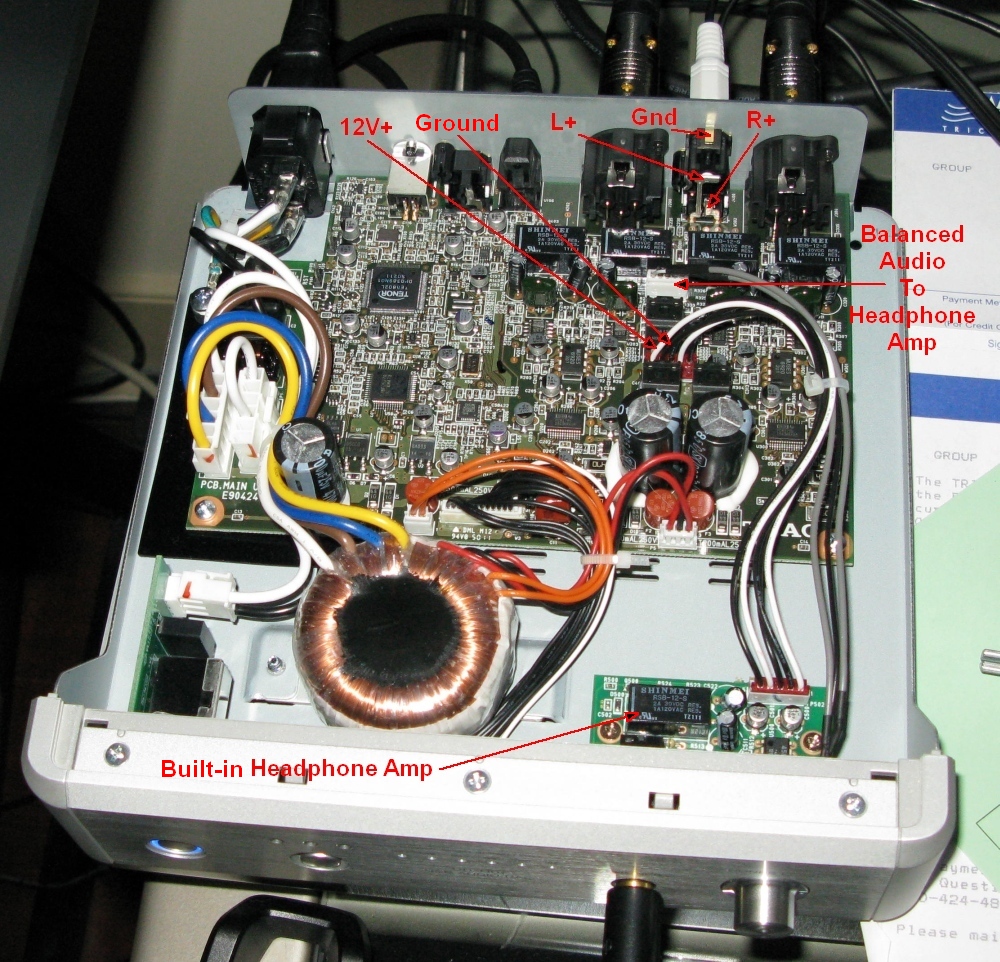
Power the amp board with the built-in headphone amp's White power wire 12v +, the adjacent Black wire is ground. Tap single ended audio (R+ L+ and Ground) for the amp board from the inside of the DAC's RCA output connectors.
The Tripath TA2024 amp board has unbalanced input--the R- & L- signals are both connected to ground at the 3.5mm TRS input jack so do not tap into your DAC's balanced signal and connect them to the amp boards TRS jack. I tapped into the UD-H01's unbalanced RCA output jacks to send the signal to the amp board's input TRS jack. The amp board needs R+, L+ and ground for input.
TRS Plug Connections
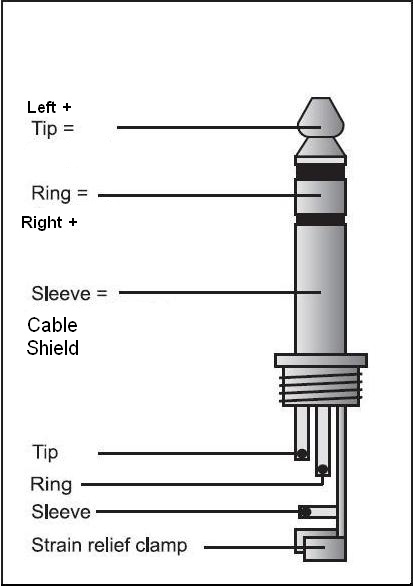
The UD-H01 sends dual 12 volt power to its built-in headphone amp. The built-in headphone amp's power connector has +12 volts on both white wires and the adjacent black wires are ground. I found some single strand wire that fit tightly into the built-in headphone amp's power connector
Tripath TA2024 Amp Board & XLR Connector Installed in Top Cover
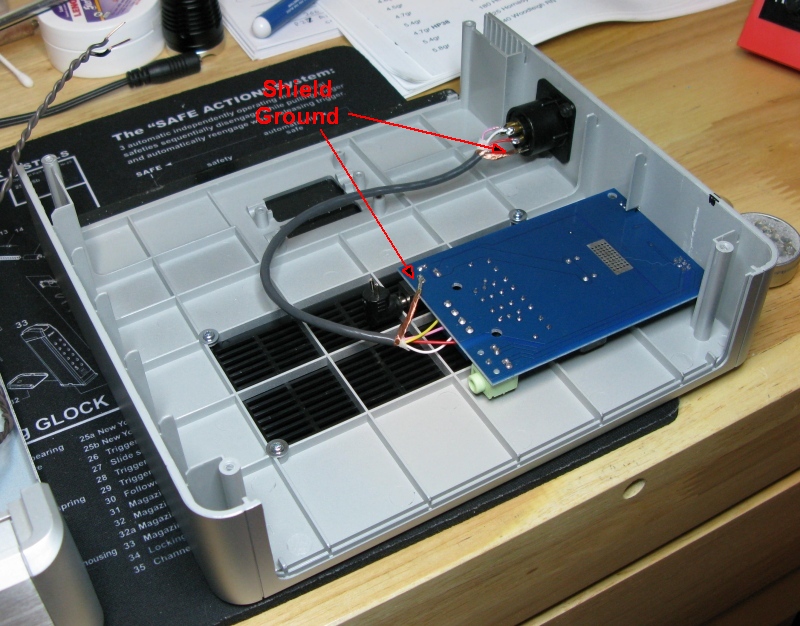
Internal Connections Ready

Power tapped from built-in headphone amp's power connector (White is 12v+, Black is ground). 3.5mm TRS plug connected to the RCA connectors. Ready to plug into the amp board. I twisted all the AC power wires (upper left) for noise reduction.
I disconnected the built-in headphone amp since I don't need a TRS jack but you can leave the built-in amp connected and just tap and solder into the built-in amp's power wires. I wouldn't try to run headphones with both amps simultaneously though--just turn the volume full down on the amp you're not using.
The volume shaft on my amp board had a 1/4 inch shaft which is the same size as Fender bass guitars. I had an extra chrome knob lying around but they are available on ebay for a few dollars.
Project Complete
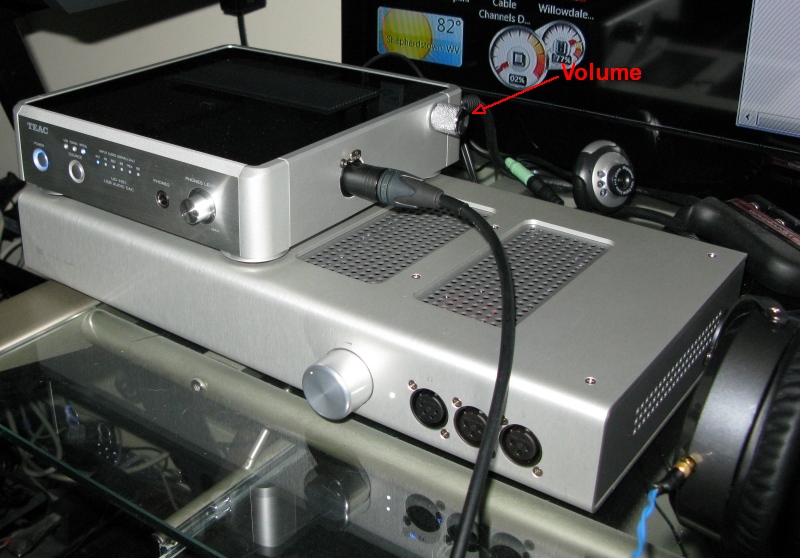
This little amp sounds freakin' great with my high end HE-500 headphones. It also sounds great with AKG K240 Studio and Fostex modified T50RP headphones. It's dead quiet even at full volume. My max listening volume comes at about 40% volume (10 o'clock) so there's lots of headroom for 600 ohm headphones. I did listening tests between the Tripath amp and my Schiit Mjolnir balanced headphone amp. I'm not going to lie and say the Tripath is the Schiit's equal but the little Tripath amp definitely holds its own. The biggest difference I hear between this amp and the Schiit is the Tripath is a little brighter with the treble a little more prominent but I only notice it with certain music. The bottom line is this little Tripath amp makes a great little balanced push-pull amp--seriously, you will be amazed at the sound quality. For $24 you can't go wrong.
Twisting the AC Wires
While you have the UD-H01 open it's a good idea to twist all the AC wiring to reduce electronic noise (see second picture up). You can remove the wires from their connector by carefully applying pressure to the exposed metal pin and pushing it up and out. After you twist the wires re-insert the metal pins into the connector. I twisted these wire pairs: White and Black wires from the AC plug to the power switch, the Brown and White wires from the coil, the Blue and Yellow wires from the coil, the two Orange wires from the coil and the Red-Black-Red wires from the coil.